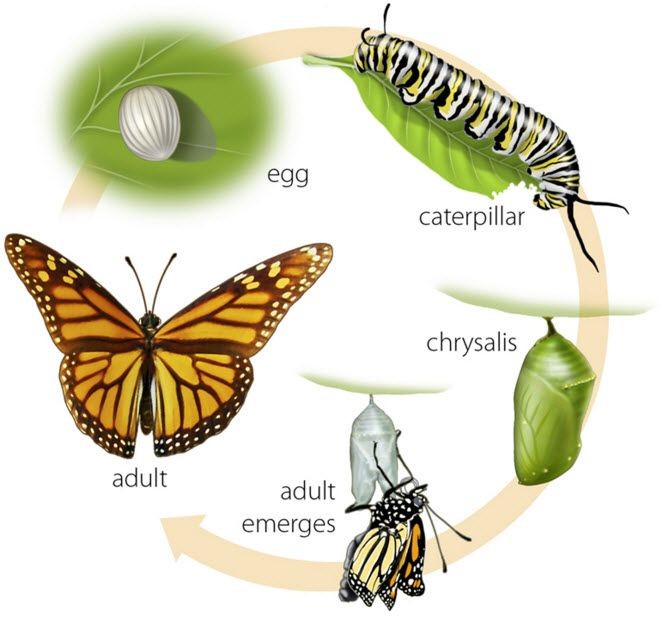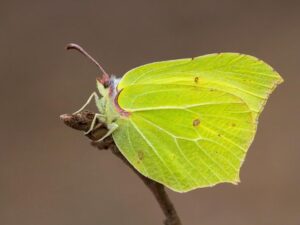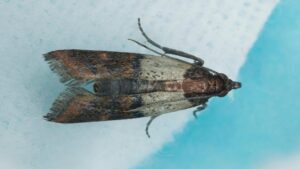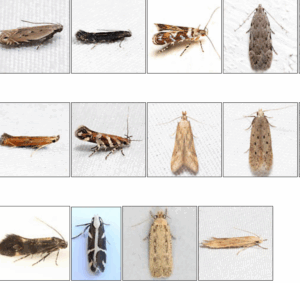Butterfly Life Cycle
The butterfly and moth develop through a process called metamorphosis. This is a Greek word that means transformation or change in shape. Insects have two common types of metamorphosis. Grasshoppers, crickets, dragonflies, and cockroaches have incomplete metamorphosis. The young (called a nymph) usually look like small adults but without the wings.Butterflies, moths, beetles, flies and bees have complete metamorphosis. The young (called a larva instead of a nymph) is very different from the adults. It also usually eats different types of food.There are four stages in the metamorphosis of butterflies and moths: egg, larva, pupa, and adult.
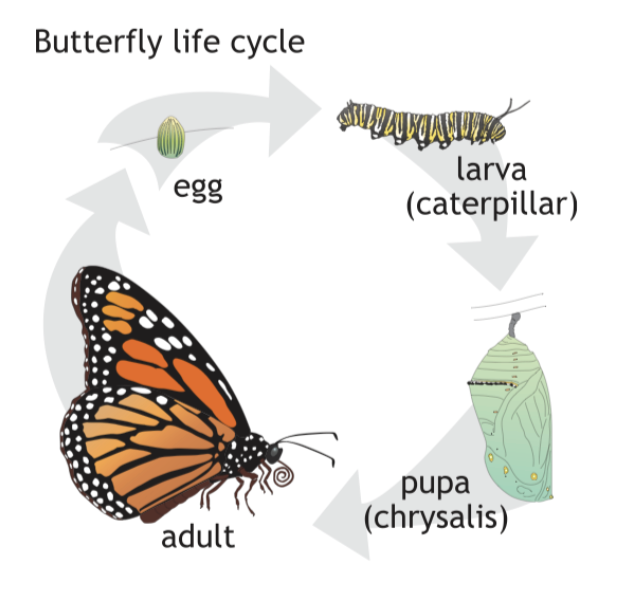
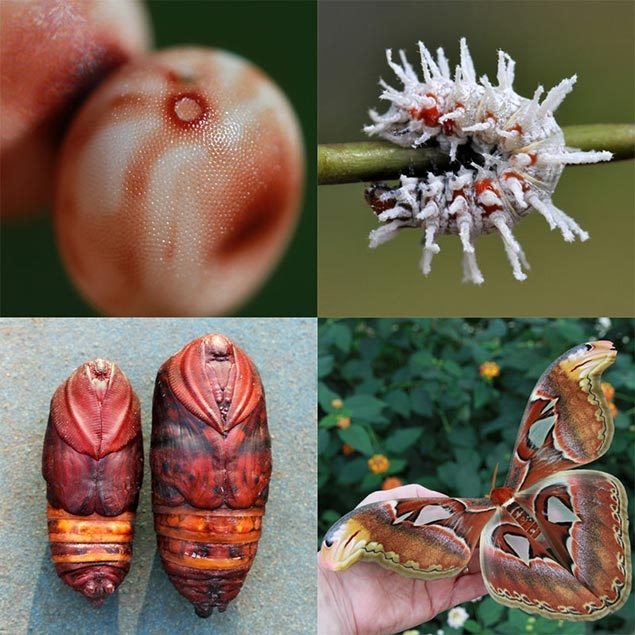
Learn how to recognize and describe the stages of a butterfly life cycle.
Metamorphosis is a series of major changes in an animal’s body form as it moves through its life cycle. Butterflies and moths undergo a complete metamorphosis, which means there are four separate stages in the life cycle (egg, larva, pupa, and adult). Each stage looks completely different and serves a different purpose in the life of the insect.
Egg Stage: Female Lepidoptera (the group butterflies and moths belong in) often require specific plants, called host plants, on which to lay eggs. A butterfly usually lays 200-500 eggs which vary in shape and size depending on the species. Most species hatch in four to five days, while others may take as long as three weeks.
Larva Stage: When the eggs hatch, tiny caterpillars begin feeding and growing. Its first meal is usually the eggshell, which provides it with important nutrients. Then it will begin eating the host plant. Almost all caterpillars eat leaves but some eat stems, roots, fruits, seeds, seed pods or flowers. They will eat only the host plant and will not move to any adjacent plant of a different species – even if it runs out of food. As they eat and their bodies expand, their skin (an exoskeleton with a limited stretching capacity) becomes tight and eventually splits and sheds, revealing new skin beneath. This is called molting and occurs several times as the larva grows.
Pupa Stage: When the caterpillar has grown enough, it finds a protected spot, molts for the last time, and forms an encasement in which they metamorphose. During this stage, most moth caterpillars spin a silken cocoon while most butterfly caterpillars form a chrysalis. The pupa undergoes tremendous change. The caterpillar releases digestive juices that break down most of its body into a “tissue cell soup” from which it develops four wings, new legs, new eyes, new mouthparts, and genitalia. When the insect emerges, its metamorphosis is complete.
Adult Stage: The fully developed adult splits the pupal case open, crawls out and hangs upside down to facilitate stretching and drying its wings. Its wings are inflated by pumping fluid into the wing veins. At this stage, the wings are very soft and wet and the butterfly/moth must remain suspended while waiting up to two hours for its wings to dry. Once the wings are stretched and dried, the adult flies off to feed, find a mate and begin the cycle again. The average adult lifespan is two weeks but ranges from several days to as long as 11 months.
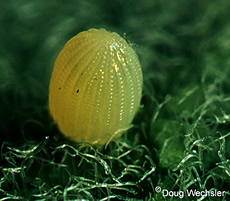
It all starts when a female butterfly lays her eggs, usually on leaves or stems of plants. Inside these tiny eggs, caterpillars grow. Depending on the species, the eggs can vary in shape and texture – they can be round, oval or cylindrical, and smooth, bumpy or wrinkled. The time it takes for the eggs to hatch can also vary – in some species, they will hatch within a few weeks and in others they will only hatch once the weather is warm enough.
Stage One: Egg
The first stage of a butterfly’s life is a very small oval, round, or cylindrical egg, depending on the species of butterfly.
Egg
Eggs are laid on plants by the adult female butterfly. These plants will then become the food for the hatching caterpillars.
Eggs can be laid from spring, summer or fall. This depends on the species of butterfly. Females lay a lot of eggs at once so that at least some of them survive.
Butterfly eggs can be very small.
Stage Two: Caterpillar
When the egg hatches, a “larva” or “caterpillar” emerges. Caterpillars must grow quickly, so they eat continually.
Caterpillar: The Feeding Stage
The next stage is the larva. This is also called a caterpillar if the insect is a butterfly or a moth.
The job of the caterpillar is to eat and eat and eat. As the caterpillar grows it splits its skin and sheds it about 4 or 5 times. Food eaten at this time is stored and used later as an adult.
Caterpillars can grow 100 times their size during this stage. For example, a monarch butterfly egg is the size of a pinhead and the caterpillar that hatches from this tiny egg isn’t much bigger. But it will grow up to 2 inches long in several weeks.
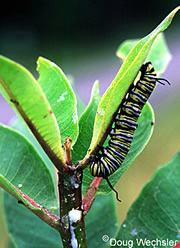
Once ready, the caterpillar leaves its egg home and enters the big outside world! And these little critters have one serious appetite – they actually eat their way out of the egg and immediately start chomping on the leaves of the host plant. During this stage, they shed their skin four or five times – as the caterpillar grows, its skin becomes too tight and splits open, revealing a new, larger skin underneath. A fully grown caterpillar can be over 100 times larger than when it emerged from its egg. Wow!
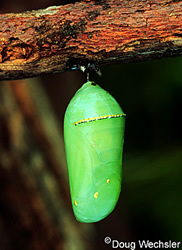
Once fully grown, the caterpillar forms itself into a “pupa” (or chrysalis) – a kind of vessel in which the caterpillar changes into a butterfly. They usually do this on twigs or safe, hidden areas around the host plant. The “pupa” stage may last a few weeks to several months depending on the species. During this time, a hardened case forms around the pupa to protect it from predators and extreme weather conditions. And inside, the tissue, limbs and organs of the caterpillar transform. The result? A wonderful winged butterfly!
Stage Three: Chrysalis
When the caterpillar reaches full size, they form into a “chrysalis” or “pupa.” Inside, they are undergoing a transformation or “metamorphosis.” The parts we recognize as a butterfly are beginning to form.
Pupa: The Transition Stage
When the caterpillar is full grown and stops eating, it becomes a pupa. The pupa of butterflies is also called a chrysalis.
Depending on the species, the pupa may suspended under a branch, hidden in leaves or buried underground. The pupa of many moths is protected inside a coccoon of silk.
This stage can last from a few weeks, a month or even longer. Some species have a pupal stage that lasts for two years.
It may look like nothing is going on but big changes are happening inside. Special cells that were present in the larva are now growing rapidly. They will become the legs, wings, eyes and other parts of the adult butterfly. Many of the original larva cells will provide energy for these growing adult cells.
Stage Four: Butterfly
The adult butterfly emerges from the chrysalis with its soft wings folded about its body. After a rest period, the butterfly pumps blood into its wings and begins to fly.
Adult: The Reproductive Stage
The adult stage is what most people think of when they think of butterflies. They look very different from the larva. The caterpillar has a few tiny eyes, stubby legs and very short antennae. The adults have long legs, long antennae, and compound eyes. They can also fly by using their large and colorful wings. The one thing they can’t do is grow.
The caterpillar’s job was to eat. The adult’s job is to mate and lay eggs. Some species of adult butterflies get energy by feeding on nectar from flowers but many species don’t feed at all.
Flying comes in handy. The adult female can easily fly from place to place to find the right plant for its eggs. This is important because caterpillars can’t travel far.
Most adult butterflies live only one or two weeks, but some species hibernate during the winter and may live several months.
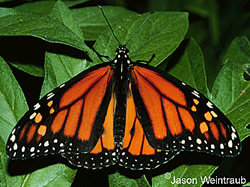
Once the butterfly is ready to emerge, the case around the pupa splits open. But it’s not time for take off just yet, as the wings are at first wet, soft and wrinkled against its body. The butterfly waits for its wings to dry, and pumps a liquid called hemolymph into them so that they become big and strong. Once fit for flight, this brilliant bug then takes to the air in search for flowers to feed on and for other butterflies to mate with.

